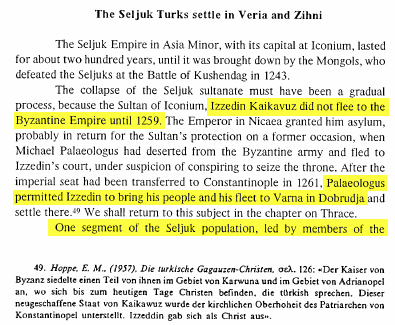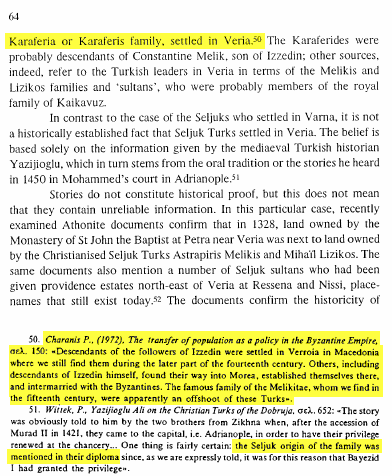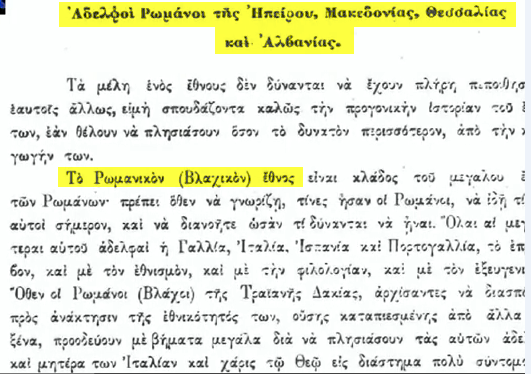The Real Ethnic Composition of Modern Greece
Collapse
X
-
1) http://www.travellingzoom.com/Blog/A...heart-of-Crete
It's been said that some people in Anopolis are Vlachs (Aromanian).
Daskalogiannis (Ioannis Vlachos)
He was born in Anopolis in 1722 from a Vlach family. Chairman of the Sfakia area, his nickname was "Daskalos" (means teacher) hence the name Daskalogiannis. With the support of Russia, he funded and raised a revolt - which started on the 25 march 1770 - against the Ottomans. Unfortunately, the russian fleet did not assist the rebellion, and by june 1771, after he finally surrendered, he was skinned alive at Heraklio by the Pasha of Candia. His death was immortalized in many poems and folk songs that celebrate his courage and dignity at the time death.
2) http://www.destinationcrete.gr/en/pl...pedio-anopolis
Anopolis was a key centre of resistance in the period of the Venetian rule and likewise in the Turkish: it paid dearly. It was destroyed by the Venetians in 1365 after the suppression of the Revolt of the Kallergoi; reoccupied under the Turks, but again – and utterly – thrown down in the revolt of Daskalogiannis in 1770. Daskalogiannis (Ioannis Vlachos) was himself from this town – from an old Vlach naval family: his statue now graces the village square.
3) The Making of the Cretan Landscape - By Oliver Rackham, Jennifer Moody
This is the first book to help the visitor understand Crete's remarkable landscape, which is just as spectacular as the island's rich archaeological heritage. Crete is a wonderful and dramatic island, a miniature continent with precipitous mountains, a hundred gorges, unique plants, extinct animals and lost civilisations, as well as the characteristic agricultural landscape of olive groves, vines and goats, Jennifer Moody and Oliver Rackham explain how the island's peculiar and extraordinary features, moulded and modified by centuries of human activity, have come together to create the landscape we see today. They also explain the formation and ecology of Crete's beautiful mountains and coastline, and the contemporary threats to the island's fragile natural beauty.
- "... Crete might seem to have escaped through being an island, but place-names and surnames show that some Slavs and Albanians settled here."
- "The medieval Venetians were among the chief colonisers of Crete: they settled their own merchants and nobles, introduced slaves and prisoners-of-war. African slaves continued to be imported until 1859."
- "Cretans are descended, to varying degrees, from Albanians, Argives, Armenians, Bulgars, Dorians, Eteocretans, French, Germans, Hebrews, Minoans, Negroes, Pelasgians, Romans, Saracens, Serbs, Spaniards, Spartans, Tartars, Turks, Venetians and Vlachs."Last edited by Carlin; 03-15-2016, 03:22 PM.
Comment
-
-
The Rabbi Benjamin of Tudela, visited Constantinople, during the reign of Manuel Comnenus (1143-1180 AD), and wrote of the Emperor's special sympathy for the Vlachs because of his origins from that people.
Comment
-
-
Armenians
The Armenians in the Byzantine Empire
by Peter Charanis
Full Extract:
[12] In his account of the revolt of Thomas the Slavonian (820--823) against the Emperor Michael II (820--829), the Byzantine historian Genesius lists a variety of peoples from whom the armies of the rebel had been drawn: Saracens, Indians, Egyptians, Assyrians, Medes, Abasgians, Zichs, Vandals, Getae, Alans, Chaldoi, Armenians, adherents of the heretical sects of the Paulicians and the Athinganoi (1). Some of these peoples are well known; the identity of others, despite efforts made to determine it, is by no means certain (2). But in any case, their listing by the Byzantine historian illustrates vividly the multiracial character of the Byzantine empire. This was in the ninth century, but the situation was not different for the period before and it would not be different for the period after. The Byzantine empire was never in its long history, a true national state with an ethnically homogeneous population.
Among the various ethnic groups in the Byzantine empire, the Armenians constituted one of the strongest. At the end of the sixth century the Byzantine empire controlled the major part of Armenia. The events of the seventh century, the rise of the Arabs in particular, deprived it of this control, but it still retained some Armenian-speaking lands. The expansion of the empire which began late in the ninth century greatly increased the extent of these lands. By the middle of the eleventh century, all Armenia was in Byzantine hands, though shortly afterwards it was permanently lost to the Seljuk Turks.
The great source of the Armenian element in the Byzantine empire consisted, of course, of the Armenian-speaking lands under its control. Thus in the eighth century, when all Armenia was in Arab hands, the [13] native Armenian population under the control of the empire was not very large; whereas, in the eleventh century when virtually all Armenia was annexed to the empire it was very considerable. But the Armenian element in the Byzantine empire was not restricted to the Armenian lands proper. It found its way into other regions of the empire.
Many Armenians came into the Byzantine empire even when Armenia was under foreign control. They came sometimes as adventurers, but more often as refugees. Thus in 571, following an unsuccessful revolt against the Persians, numerous Armenian noblemen, headed by Vardan Mamikonian and accompanied by the Armenian Catholicus and some bishops, fled to Constantinople (3). Vardan and his retinue entered the Byzantine army; the rest seem to have settled in Pergamon where an Armenian colony is known to have existed in the seventh century. It was from this colony that Bardanes came who, as Phillipicus, occupied the imperial throne from 711 to 713 (4).
The religious ferment in Armenia which in the seventh century gave rise to the Paulician sect had the effect of bringing more Armenians into the Byzantine empire. Armenian Paulicians, driven from their homes sometime before 662, settled in the empire, especially in the region of the junction of the Iris and the Lycus rivers in the territories of the Pontus. Their settlements extended almost as far as Nicopolis (Enderes) and Neocaesarea (Niksar) (5). These were regions where the Armenian element was already considerable. Comana, for instance, is referred to by Strabo as the market of the Armenians (6).
The discontent caused by the Arab conquest of Armenia forced other Armenians to seek refuge in the territories of the empire. Thus, about 700 a number of nakharars [lords] with their retinue fled to the Byzantine empire and were settled by the Emperor on the Pontic frontier. Some of these later returned to Armenia, but others remained (7). More nakharars, completely abandoning their possessions in Armenia, fled to the Byzantine empire during the reign of Constantine V Copronymus (8). [14] Still more came about 790. It is said they numbered 12,000 and they came with their wives, their children, their retinue and their cavalry. They were welcomed by the Emperor and were granted fertile lands upon which to settle (9). We are not told the location of the lands given to them. As their title implies these refugees belonged to the Armenian nobility, who were sometimes criticised for fleeing the country and thus abandoning the poor to the mercy of the Arabs (10). Mass migrations such as took place in the course of the seventh and eighth centuries seem to have subsided in the ninth, but individual Armenians continued to come into the Byzantine empire to seek their fortunes.
The Armenians, however, did not always come willingly. They were sometimes forcibly removed from their homes and settled in other regions of the empire. Justinian had already resorted to this practice, but the numbers involved were small, perhaps a few families (11). Transplantations on a large scale took place during the reigns of Tiberius and Maurice. In 578, 10,000 Armenians were removed from their homes and settled in the island of Cyprus. "Thus", says Evagrius, "land, which had been previously untilled, was everywhere restored to cultivation. Numerous armies also were raised from among them that fought resolutely and courageously against the other nations. At the same time every household was completely furnished with domestics, on account of the easy rate at which slaves were procured" (12).
Comment
-
-
Continued from above.
This volume traces the social, economic and political history of the Greeks between 500 and 1050. The book adopts an interdisciplinary approach and uses archaeological evidence, as well as coins and seals, fiscal documents, medieval chronicles, and hagiographic literature to examine the development of Greek culture in the early medieval period. Several themes provide the foundation for this volume and run through the chapters; these include the Balkan context, the Social Role of the Army and the Onset of Economic Growth. Special attention is paid to the size of the economy in early medieval Greece. Both the social and the economic are privileged and analyzed together as integrally connected spheres of life, thus filling a major gap in existing literature on this period.
Source: The Edinburgh History of the Greeks, c. 500 to 1500, by Florin Curta -> Page 288 and Page 289 Quotes/Summary:
- 'Kapheroi, Thrakesians, Armenians, and others from different places and cities' settled in Peloponnesos in the early ninth century, while Armenians 'and other rabble' came to Crete in the aftermath of the island's conquest in 961.
- The Kapheroi may well have been converted Arabs from the eastern frontier of the Empire.
- A people called the 'Mardaites' were settled and lived in Kephallenia, Peloponnesos, Pamphylia (it is said that they seem to have been moved to the Greek lands from Pamphylia).
- There were communities of Athinganoi ('untouchables') on the island of Aigina. They may have arrived there from Asia Minor.
Comment
-
-
Comment
-
-
Here we have the Greeks livid and furious with Macedonians for building a couple of statues and renaming an airport and highway with ancient Macedonian figures, when in the 1800s the West erased every sense of who the Greeks really were and replaced it with ancient mythologies and ideas. So fitting that they tout themselves as being the "cradle of democracy," but if not for a Western monarch, today they wouldn't be considered Greeks nor the initiators of democracy.Originally posted by Vladimir View Post
Who in the world do they think they are trying to dictate to the Macedonians how to name themselves and define themselves and interpret their own history when the Greeks are so ignorant of their own history? Their arrogance, ignorance and chauvinism makes them the the most dangerous and pathetic country in the Balkans today, and most likely all of Europe.
Comment
-
-
The 10th century Byzantine anonymous epitomizer of Strabo wrote:
«Καὶ νῦν δὲ πᾶσαν Ἤπειρον καὶ Ἑλλάδα σχεδὸν καὶ Πελοπόννησον καὶ Μακεδονίαν Σκύθαι Σκλάβοι νέμονται»
"And now most of Epirus and Hellas and Peloponnesus and Macedonia are inhabited by 'Scythi-Slavs'."
Vgl. Müller, Geographi Graeci Minores II S. 574.
And for Western Peloponnese in particular:
«Νῦν δὲ οὐδὲ ὄνομά ἐστι Πισατῶν καὶ Καυκώνων καὶ Πυλίων· ἅπαντα γὰρ ταῦτα Σκύθαι νέμονται»
s. Müller, Geogr. Graeci Minores II S. 583.
"And now not even the names of the Pisatans, the Caucones or the Pylians survive. All these regions are inhabited by 'Scythians'"
Comment
-
-
Truth and facts alone will not convince the modern Greek chauvinists and nationalists that they are unrelated to Hercules or Zeus.Originally posted by Carlin View PostThe 10th century Byzantine anonymous epitomizer of Strabo wrote:
«Καὶ νῦν δὲ πᾶσαν Ἤπειρον καὶ Ἑλλάδα σχεδὸν καὶ Πελοπόννησον καὶ Μακεδονίαν Σκύθαι Σκλάβοι νέμονται»
"And now most of Epirus and Hellas and Peloponnesus and Macedonia are inhabited by 'Scythi-Slavs'."
Vgl. Müller, Geographi Graeci Minores II S. 574.
And for Western Peloponnese in particular:
«Νῦν δὲ οὐδὲ ὄνομά ἐστι Πισατῶν καὶ Καυκώνων καὶ Πυλίων· ἅπαντα γὰρ ταῦτα Σκύθαι νέμονται»
s. Müller, Geogr. Graeci Minores II S. 583.
"And now not even the names of the Pisatans, the Caucones or the Pylians survive. All these regions are inhabited by 'Scythians'"
But thank you for posting these sources and continue the good work!
Comment
-
-
Thanks vicsinad.Originally posted by vicsinad View PostTruth and facts alone will not convince the modern Greek chauvinists and nationalists that they are unrelated to Hercules or Zeus.
But thank you for posting these sources and continue the good work!
Here's an interesting one (one more) -
Weigand, G., (1895), Die Aromunen Ethnografische – philologisch – historische Untersuchung, page 211:
“Georgios Olympios, eines Aromunen aus Fteri, von den Turken Vlach-Bey genannt, eines Andrutsu und dessen Sohnes Odysseus aus Vlacho-Livadhon.”
English:
“Georgios Olympios, an Aromanian from Fteri, called by the Turks Vlach-Bey…”
Comment
-
-
Source: Les Tzacones, By Stamatis C. Caratzas
Page 101: “Nous pouvons donc bien supposer que le terme Tzacones etait connu en Allemagne au 13eme siecle comme designant de nombreux heretiques dont une partie habitait dans des pays allemands et etait slavophone.”
Page 101: “So we can well suppose that the term Tzacones was known in Germany in the 13th century as designating many "heretics" that lived in a part of German countries and was Slavophone.”
--> In German lands, in the 13th century, the 'Tzaconians' were known and understood as Slavic-speakers.
Comment
-
-
The Tzaconians seem to share a name with the Tsakonians of the Peloponnese. And the slavic connections to the region are not able to be disputed. Interesting.Risto the Great
MACEDONIA:ANHEDONIA
"Holding my breath for the revolution."
Hey, I wrote a bestseller. Check it out: www.ren-shen.com
Comment
-
-
Source: "The Quest for Hellenism: Religion, Nationalism, and Collective Identities in Greece (1453-1913)", by Dimitris Livanios.
Page 40:
A thousand years later, around 1891, a Greek nationalist visited Asia Minor, the land of St Gregory, only to receive to his considerable distress exactly the same answer:
For if today you ask a Christian, even one speaking a corrupted Greek: "What are you?", "A Christian (Christianos)," he will unhesitantly reply. "All right, but other people are Christians, the Armenians, the Franks, the Russians..." "I don't know," he will answer, "Yes, these people believe in Christ but I am a Christian." "Perhaps you are a Greek?" "No, I am not anything, I've told you that I'm a Christian, and once again I say to you that I am a Christian!..."
Comment
-
-
It appears that some Seljuk Turks found their way into Morea (Peloponnesus), and established themselves there. (Were there any other Turks that settled and established themselves in Morea, that went unnoticed by the historians?)
Page 63 -

Page 64, observe footnote 50 -

Source: George Nakratzas, The Close Racial Kinship Between the Greeks, Bulgarians, and Turks.
Comment
-



Comment